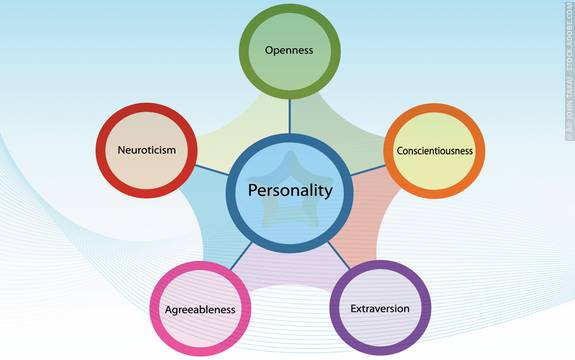Describe the Five Factor Model of Personality
Five-Factor Model Description and Measurement. The five-factor model of personality FFM is a set of five broad trait dimensions or domains often referred to as the Big Five.

The Five Factor Model Of Personality Download Scientific Diagram
The Five-Factor Model of Personality is a system used in order to describe an individuals personality traits.

. EysenckTellegans superfactors why they did not stick. Five-factor model of personality. Introversion openness or unconventionality agreeableness vs.
The five-factor model of personality is a hierarchical organization of personality traits in terms of five basic dimensions. The results of repeated independent studies have yielded interpretations. As stated by the Five-Factor Model of Personality people who score high on agreeableness tend to believe that most people are trustworthy and honest and they themselves tend to be trusting cooperative and friendly.
Five-factor model of personality in psychology a model of an individuals personality that divides it into five traits. By requiring said individual to answer a series of questions this test is able to decipher the traits that are most likely evident within their life. Evidence of this theory has been growing over the past 50 years beginning with the research.
The five broad personality traits described by the theory are extraversion also often spelled extroversion agreeableness openness conscientiousness and neuroticism. Personality traits are understood as patterns of thought feeling and behaviour that are relatively enduring across an individuals life span. Tap card to see definition.
Extraversion Agreeableness Conscientiousness Neuroticism. Five-Factor Model of Personality History of Five-Factor Model. Five factor theorists are one set of traittheorists.
Antagonism and conscientiousness or constraint vs. Thefive factor theory is a fairly recent proposal and has its basis in earlier workwhich shall be discussed. Openness conscientiousness extraversion agreeableness and neuroticism.
The openness to experience dimension of personality is characterised by a willingness to try new. Treatment of Antisocial personality disorder. Each trait represents a continuum.
A Critical Appraisal Dan P. Click card to see definition. Therefore the present study investigated the five personality domains of Neuroticism Extraversion Openness Agreeableness and Conscientiousness as measured by the NEO Five Factor Inventory NEO-FFI in a sample of 93 adults seeking speech treatment for.
Openness to Experience Closed to Experiences Conscientiousness Lack of Conscientiousness Extraversion Introversion Agreeableness Disagreeableness Neuroticism Emotional Stability. It is important to note that these five factors are distinct and neither low nor high scores are necessarily better or good or bad. However people who score low have less empathy are more aggressive and are generally less concerned with others well-being.
The Five Factor Model FFM of general personality structure consists of the five broad domains of neuroticism or emotional instability vs. Antisocial personality disorder is a specific psychiatric disorder characterized by antisocial and impulsive behaviors. Five Factors at a Glance Openness to Experience.
This is a pathological disorder which means that modern psychiatry defines no potential benefits of positive antisocial behavior. The origins of the FFM can be traced to William McDougalls proposal in 1932 that. People who are conscientious are more aware of their actions and the consequences of their behavior.
Taken from McCrae and Costa 2003. Extraversion Agreeableness Conscientiousness Neuroticism sometimes named by its polar opposite Emotional Stability and. The general descriptions of extraversion neuroticism openness agreeableness and conscientious are listed in Table 132.
As a result the five-factor theory emerged to describe the basic traits that serve as the building blocks of personality. Currently McCrae Costas 1992 Five-Factor Model FFM of personality is probably the most popular and accepted trait theory in personality psychology. Individuals can fall anywhere on the continuum for each trait.
The traits that constitute the five-factor model are extraversion neuroticism openness to experience agreeableness and. McAdams Northwestern University ABSTRACT This critical appraisal aims to position the five-factor model within the multifaceted field of personality psychology by highlighting six im-. The Big Five remain relatively stable throughout most of ones lifetime.
The Five-Factor Model In Personality. Previous research has not explored the Five Factor Model of personality among adults who stutter. Extraversion Agreeableness Conscientiousness Neuroticism and Openness to Experience.
The Five-Factor Model of Personality test gives the test subject a series of situational options. The Big Five personality traits are extraversion also often spelled extroversion agreeableness openness conscientiousness and neuroticism. The claim of five factor theorists is that behaviour can be bestpredicted and explained by measurement of five dominant personality factors.
What Are the Big Five Dimensions of Personality. Costa and McCraes well-known and now revised NEO Personality Inventory NEO-PI-R is widely used as a. The five-factor model groups personality traits into five factors.
Today many researchers believe that they are five core personality traits. The five-factor model of personality FFM is a set of five broad trait dimensions or domains often referred to as the Big Five. Many contemporary personality psychologists believe that there are five basic dimensions of personality often referred to as the Big 5 personality traits.

Five Factor Model Of Personality Psychologist World

16 1 Personality Traits Introduction To Psychology

The Five Factor Model Of Personality Download Scientific Diagram
No comments for "Describe the Five Factor Model of Personality"
Post a Comment